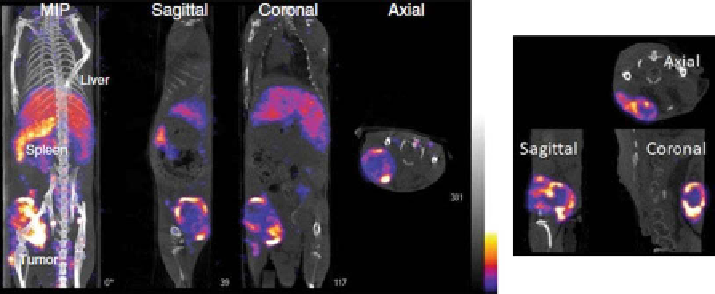Biomedical Engineering Reference
In-Depth Information
figuRe 7.1
In vivo
SpeCT/CT images of sarcoma 180-bearing mice 24 h after administration
of
111
In-labeled liposomes. Case #1 (left panel): whole-body images containing maximum
intensity projection (mIp) and representative sagittal, coronal, and axial slice images contain-
ing the tumor. Case #2 (right panel): representative sagittal, coronal, and axial slice images of
the tumor site in another mouse. The SpeCT projection data were acquired under the optimized
conditions for
in vivo
imaging. The acquisition time was 150-300 s per projection with 24
(6 × 4) directions, total = 1-2 h. (With permission from Ref. [50]. © Springer.) (
See insert for
color representation of the figure.)
A number of liposome probes have been radiolabeled with
99m
Tc,
111
In, and
67
ga.
pegylated liposomes encapsulated with
111
In-diethylenetriaminepentaacetic acid
(DTpA) have been used to target solid tumors [49, 50]. Radiolabeling was performed
by a transchelation reaction between a lipophilic oxine and hydrophilic DTpA ligands.
The sensitive spatial resolution of the SpeCT camera, coupled with effective targeting
of the
111
In-DTpA-labeled liposomes, showed intratumoral heterogeneity of the radio-
labeled liposome (fig. 7.1) [50, 51]. Although there was elevated accumulation in the
liver and spleen, the tumor accumulation 24-48 h post-injection (p.i.) was between
0.26 and 1.2 mbq/g of tumor (5-10% ID/g). by using
111
In-DTpA-labeled pegylated
liposomes, Harrington
et al
. also observed high uptake in head and neck cancers
(33.0 ± 15.8% ID/kg), moderate uptake in the lung tumors (18.3 ± 5.7% ID/kg), and
low uptake in breast cancers (5.3 ± 2.6% ID/kg). Their data demonstrated that
pegylated liposomes can be utilized as therapeutic agents for solid tumors, especially
head and neck tumors. The toxicity level was minimal with only one out of 17 patients
exhibiting some acute reactions that subsided after a few minutes. The major clearance
route was through the liver, which reached a maximum retention at 4 h p.i., and the spleen
[49]. for active targeting of pegylated liposomes, elbayoumi and Torchilin prepared
111
In-labeled liposome systems modified with mAb2C5 for gamma-imaging of tumors.
The mAb specifically interacts with the surface-bound nucleosomes of tumor cells,
but not normal cells. biodistribution data showed that the accumulation in the tumor
of the
111
In-labeled liposome systems was almost double that of the surrounding
tissue. Additionally, gamma-imaging showed enhanced tumor visualization with the
111
In-labeled liposomes as compared to the control radio formulations [52]. In a
related mice study, more
111
In loading of pegylated liposomes was achieved via the

Search WWH ::

Custom Search